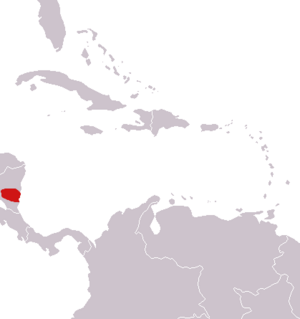Richmond's squirrel facts for kids
Quick facts for kids Richmond's squirrel |
|
|---|---|
| Conservation status | |
| Scientific classification | |
| Genus: |
Sciurus
|
| Species: |
richmondi
|
 |
|
| Richmond's squirrel's range | |
The Richmond's squirrel (Sciurus richmondi) is a type of tree squirrel. It lives only in Nicaragua, which means it is endemic to that country. People in Nicaragua sometimes call it the ardilla del rama. Scientists think it might be the same species as the red-tailed squirrel (Sciurus granatensis).
Contents
About Richmond's Squirrel
This squirrel was first described in 1898 by a scientist named Nelson. He studied some squirrels collected in 1892. More squirrels were collected in the early 1900s. Then, many years passed before more were found in the 1960s. Since then, not many scientific observations have been recorded.
What Does a Richmond's Squirrel Look Like?
Richmond's squirrels look a lot like a smaller version of the red-tailed squirrel. They are not as brightly colored. Their tail hairs are also lighter. They have a brown back and a brown tail. The tail has yellowish-brown streaks. Their belly is orange. Female squirrels have wider cheekbones than males. Otherwise, they look very similar.
Where Do Richmond's Squirrels Live?
These squirrels are found only in Nicaragua. They mostly live in the lowlands. This is along the Atlantic coast, from the border of Costa Rica up to Honduras. People think they do not live on the Pacific coast. However, some have been found near Lake Nicaragua.
What Kind of Home Do They Like?
Richmond's squirrels live in tropical and subtropical dry broadleaf forests. They have been seen in trees near streams. They also live in areas with farms, like cacao plantations. Sometimes they are found in younger forests that have grown back. They can live from lowlands up to about 1,000 meters high.
Richmond's Squirrel Behavior and Life Cycle
This squirrel is active during the day. This means it is diurnal. It probably lives alone. It looks for food on the ground. It also searches in the lower parts of trees. You will not often see it in the very top branches. It prefers tree trunks and lower branches.
How Do Richmond's Squirrels Reproduce?
Richmond's squirrels have a long breeding season. It lasts from at least February to September. Females usually have three young at a time. Sometimes they have two. Scientists have also reported that these squirrels might shed their fur twice a year.
Other Squirrels Like Richmond's Squirrel
The Richmond's squirrel is closely related to the red-tailed squirrel (Sciurus granatensis). The red-tailed squirrel lives just across the border in Costa Rica. Genetic studies suggest they might even be the same species. Scientists have thought this for a long time.
Another squirrel, Deppe's squirrel (Sciurus deppei), also lives in the same areas. However, Deppe's squirrels prefer higher places. They are similar in size and color. They also behave in similar ways.
Conservation of Richmond's Squirrels
People sometimes hunt Richmond's squirrels for food in Nicaragua. Scientists thought this animal was rare in the past. In 1996, it was listed as 'Lower Risk/near threatened'. This means it was close to being threatened.
In 2008, the squirrel was listed as 'Near Threatened' again. This was because its known living area was about 20,000 square kilometers. Experts thought its population might be shrinking. This could be due to deforestation. Deforestation means cutting down forests. This is a big threat to the Richmond's squirrel.
Images for kids



